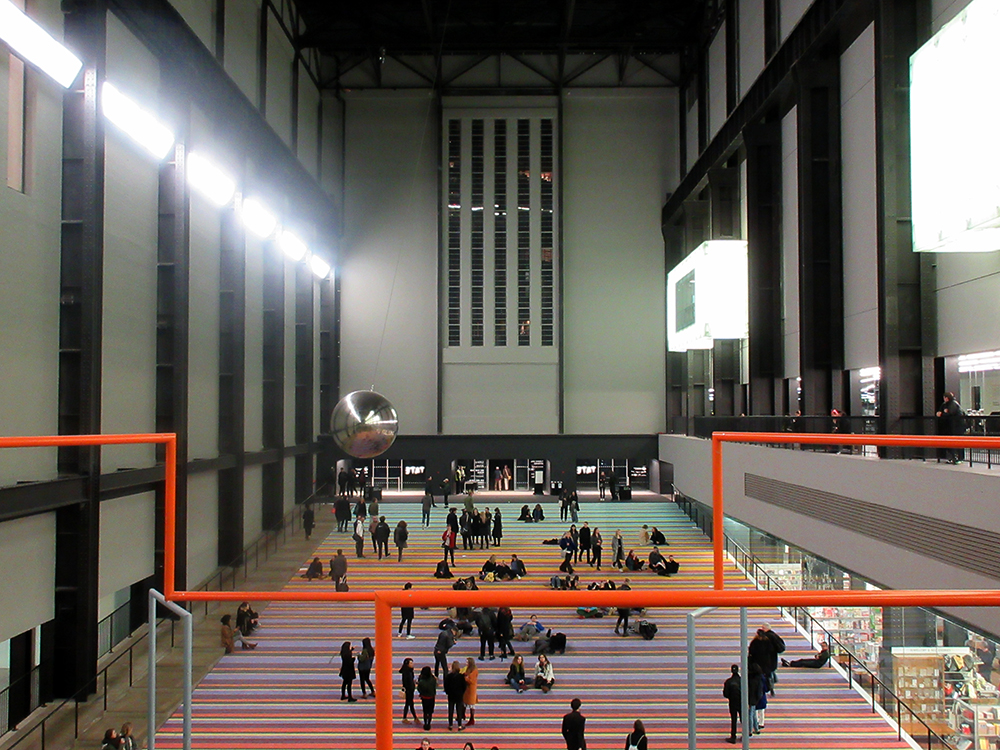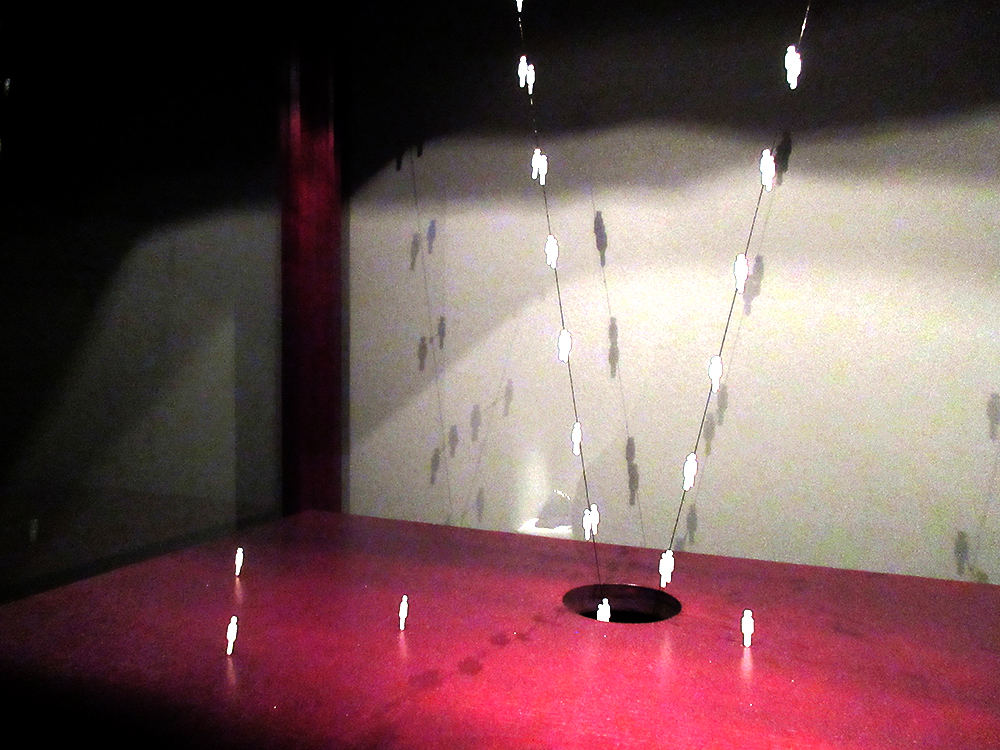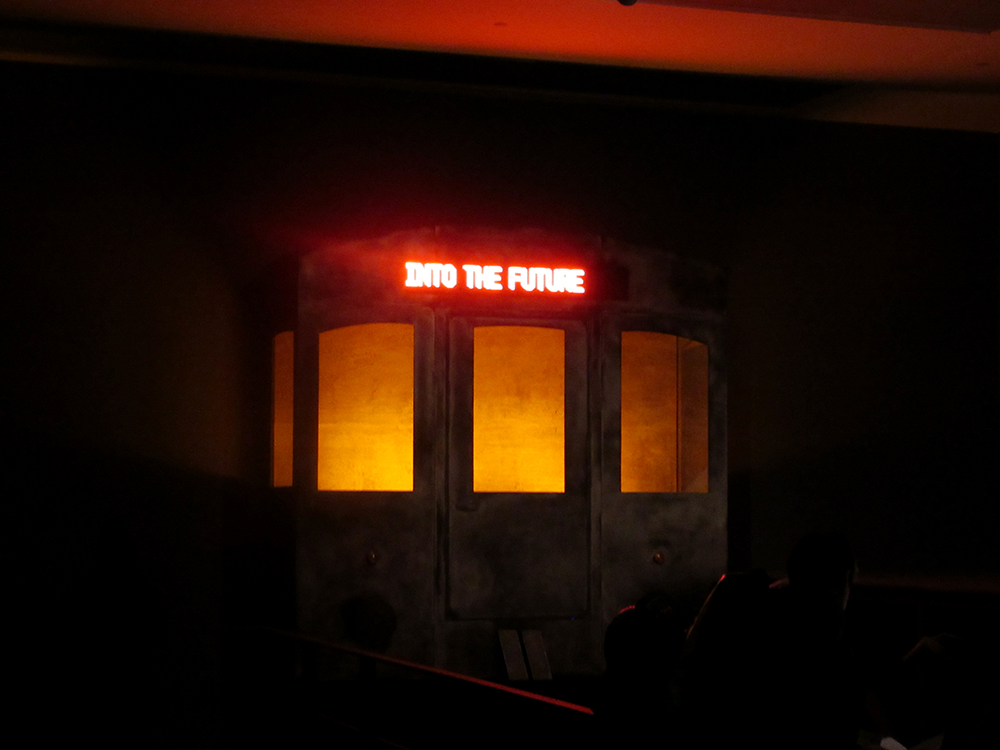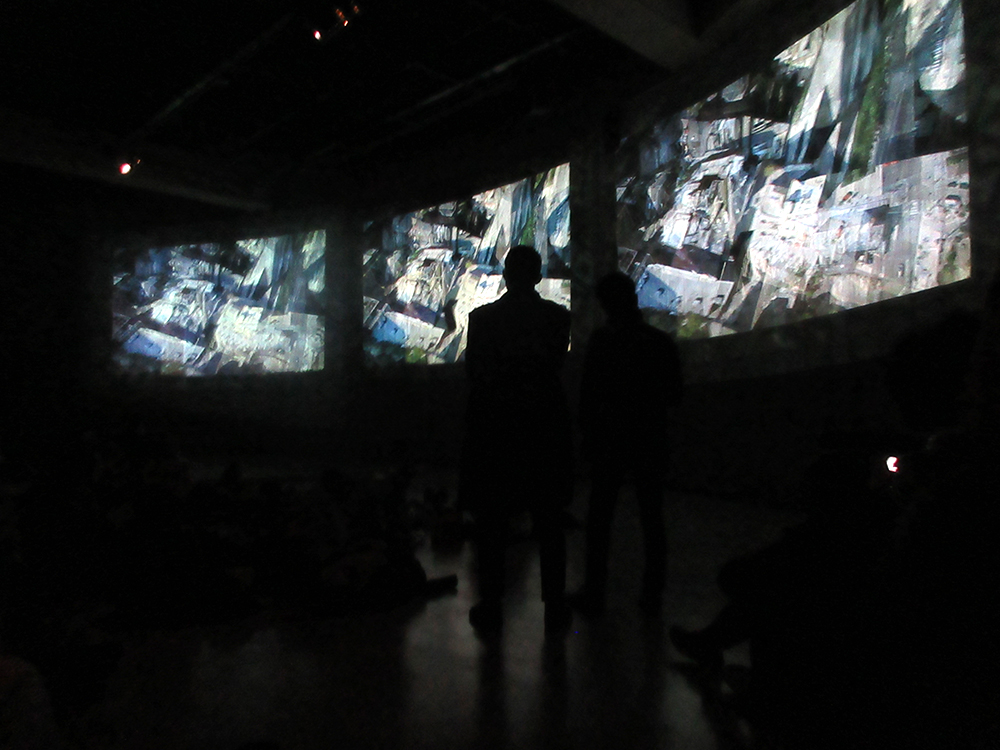I had an evening of interesting encounters at Tate Modern recently.
I went to the November edition of the Tate Lates programme to see Not Everyone Will Be Taken Into The Future, a retrospective exhibition of work by Ilya & Emilia Kabakov, and Foldings, an A/V performance by Lee Gamble & Dave Gaskarth.
I’ve tried to see Gamble two or three times now in as many months – in orbit of his ace new record on Hyperdub, Mnestic Pressure – but I’ve had to abort each attempt following day job exhaustion. This time I was successful, thankfully, but it was nonetheless defined by an all too familiar sense of inertia.
Immediately upon entering the Turbine Hall, I was greeted by the sight of people lying on their backs, staring at the ceiling, as if Olafur Eliasson’s sun had never left. These visitors were instead gazing up at a giant mirror ball, swinging from a pendulum, hypnotised by their own distorted reflections.



There was a distinct Three-Body Problem vibe to the whole scene (although I’d blame that on having finished the book on the bus on the way over):
Wang walked around the building and was greeted by a breathtaking sight: a colossal pendulum that seemed to stretch between the sky and the earth. In fact, Wang had seen it peeking out from behind the building, but he didn’t know what was happening.
The pendulum resembled those constructed by Fu Xi to hypnotise the sun god during the Warring States Period, back when Wang Miao first logged on to Three Body.
[…]
Wang gazed up at the massive pendulum overhead. In the dawn light, it was crystal bright. Its deformed mirrorlike surface reflected everything around it like the eye of the world. [1]
The rest of the Turbine Hall was filled with three-body swings, all part of an installation called One, Two, Three, Swing!:
Each swing has been designed for three people by Danish artists’ collective SUPERFLEX. Swinging with two other people has greater potential than swinging alone and One, Two, Three, Swing! invites us to realise this potential together. Swinging as three, our collective energy resists gravity and challenges the laws of nature.
As a way of smuggling in ruminations on collective practice, watching people gather momentum together to achieve near-180° arches is fun, but I’m not sure how they are changing the laws of nature… The inherent risk of grown adults on swings killing each other, proving Newton’s Third Law of Motion on their back swing, is very much part of the thrill of the spectacle but risks violently demonstrating the laws of nature more than anything.
Shout out to the small children running around care-free repeatedly dragged clear by impressively agile parents. It is in those instances alone that the laws of nature are bent.
This sense of danger aside, as I left the Tate later that night I was struck by the installation’s inherent impotence, compounded by the other art seen that evening.
Gamble and Gaskarth’s performance was the main attraction for me that evening but, having arrived straight from work three hours before they started, I decided to look around the other exhibitions.
Not Everyone Will Be Taken Into The Future, a retrospective exhibition of work by artist duo Ilya & Emilia Kabakov, was a pleasant surprise. One of three Russian-themed exhibitions tying in with the centenary of the October Revolution, it was an uncomfortable sort of celebration, not unlike the celebrations that have been ubiquitous throughout shops and art institutions across London over the last month: all failing to sufficiently bury the tension between a desire to explore revolutionary politics and appeal to the capital’s oligarch community; a nuanced mess now fading away to make way for the more familiar spectacle of annual Christmas excess.
(This trip to Tate Modern was also the first time I noticed that the newly-built extension has been named after oil-dealing philanthropist, richest man in Britain and King Oligarch, Leonid Valentinovich Blavatnik – a news item from earlier this year that I was completely oblivious to prior to seeing his surname newly installed on various bits of signage – Switch House, whatever that name was meant to signify, was surely better than the Blavatnik Building…)
Much of the Kabakov exhibition is made up of montage paintings, made with both banal and unusual materials. The meaning of these works is too often lost in translation, as so many of the paintings rely on their parodic Russian text, lampooning versions of typographic Soviet PSA and propaganda posters whose meaning is surely lost on anyone under 30 and not from Russian. I certainly welcome the inclusion of Russian art and do not want all art shown in the Tate to appeal to my parochial worldview, but I nonetheless resent having no option but to read the small print to get the joke. That fault lies with the Tate and its at times painfully amateurish presentation.
The exhibition becomes more and more accessible as the Kabakov’s artistic practice moves from painting to sculpture and “total” installations – that is, full-room installations that are all the more striking to experience in these usually clinical white spaces.
The Tate’s special exhibitions are regularly labyrinthine – often surprisingly big and never quite aligning to the mental map of the building acquired from a familiarity with the public displays. The Kabakov’s exacerbate this wonderfully. The sense of disorientation whilst walking through the exhibition was as thrilling as it is disconcerting. It is a special kind of experience to feel dwarfed and irrelevant before (not-land) art that you nonetheless know was made by human hands.
Echoing this, many of the smaller works in the exhibition feature the recurring motif of dwarfed white figures and it is hard not to feel like one, wandering through oversized dioramas.

This desire for escape continues to run through the rest of the exhibition, being introduced most explicitly in the pair’s first “total” installation, The Man Who Flew Into Space From His Apartment, which fills a box room with proportions that are familiar to many London residents.
In fact, it is almost exactly the same size as the room I spent most of last twelve months in… A desire for violent escape is inherent to those kinds of overpriced hovels that can be found all over this city.
The room is plastered with wall-to-wall Soviet propaganda, the bed rigged with some sort of ejector seat that has catapulted its inhabitant into the cosmos.

This theme of escape and a teasing view of Russian cosmism is later inverted, however, by the installation which gives the retrospective its name: Not Everyone Will Be Taken Into The Future.
After a few more rooms of small-scale sculptures and installations, you enter an enormous room that has been transformed into a railway platform, discarded artworks tumbling onto the tracks in the wake of a train with a scrolling message that loops the name of the work in English and Russian – commiserations where you’d normally expect a final destination.


The piece is, apparently, according to the small print, critiquing the strict and selective appraisal of art both by the Soviet state and the Western art world – so much art is lost to the ever-accelerating train of history. However, considering all of the Kabakov’s work up to this point in the exhibition, I am reminded of Herbert Marcuse’s various writings on art as the “Great Refusal”.
Throughout whole periods of civilization, art appears to be entirely integrated into its society. Egyptian, Greek, and Gothic art are familiar examples; Bach and Mozart are usually also cited as testifying to the “positive” side of art. […] The decisive distinction is not the psychological one between art created in joy and art created in sorrow, between sanity and neurosis, but that between the artistic and the societal reality. The rupture with the latter, the magic or rational transgression, is an essential quality of even the most affirmative art; it is alienated also from the very public to which it is addressed. No matter how close and familiar the temple or cathedral were to the people who lived around them, they remained in terrifying or elevating contrast to the daily life of the slave, the peasant, and the artisan – and perhaps even to that of their masters. [2]
I wonder how it feels for the Kabakov’s to now be brought into the future. Now they’re on the train, will they want back off?
The final room of the exhibition takes another turn, trading their parodic critiques and ressentiment in for a strange Messianism. The outlandish, and arguably still parodic, attempts to reach their Great Redeemer close out the exhibition.
The Kabakov’s seem to have escaped their drudgery, but for what…?

Gamble and Gaskarth’s Foldings is perhaps the answer to where the Kabakov’s now find themselves.
Gamble at first begins by filling Tate Modern’s Tanks with the chorus of jackhammers as Gaskarth unfolds digitally rendered aerial views of London, swooping through familiar and unfamiliar landscapes. The effect is disorientating.


The escape demonstrated before us is absolute – together, the pair fly through three and four dimensions, and then beyond, eventually swirling through atoms and unknown particles before emerging on a landscape that is altogether alien. Gamble’s audio performance echoes this comprehensive flight between states of matter, as if processing the vibrations that trail in the wake of Gaskarth’s multi-dimensional unfoldings.
There is a strange sense that the double-pincer of de/construction that the original sound of the jackhammer is readily associated with has been infiltrated most radically. Gamble explores the fractal spaces that explode into existence between each note of the machine’s incessant pounding. As the jackhammer sends a surrounding of dust and air into violent disarray, Gamble provides a map of its sonic topography, giving sound shape and shape sound.


Eventually, the pair bring us back to familiar territory, although the view of London now is irreparably changed. It is London with all dimensions seen at once and it is beautiful, serene, perforated and mutated by quantum exit pressure.


When the performance is over, the scattered audience respond with their own cacophony and return to the London they know.
The desire for escape nonetheless remains, now even more intensive than before. However, having experienced exits across various planes this evening, there is something disheartening about returning to SUPERFLEX’s three-body swings before leaving the building. The perpetual back and forth seems like a waste of energy, far too inertial in light of all that I’ve experienced tonight – an preemptive hypnotism against following Gamble and Gaskarth through to another earth.
I head out onto the street, walking past more swings outside, and into the night, all too aware of my dumb bipedal perspective.
[1] Cixin Liu, The Three-Body Problem, trans. Ken Liu (London: Head of Zeus, 2016), 254; 256
[2] Herbert Marcuse, One-Dimensional Man (London: Routledge Classics, 1991), 66


2 Comments